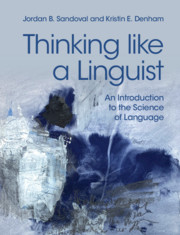Refine search
Actions for selected content:
6584 results in Grammar and Syntax
46 - Converbs
-
- Book:
- Turkic
- Published online:
- 13 August 2021
- Print publication:
- 26 August 2021, pp 750-762
-
- Chapter
- Export citation
26 - Postpositions
-
- Book:
- Turkic
- Published online:
- 13 August 2021
- Print publication:
- 26 August 2021, pp 542-554
-
- Chapter
- Export citation
13 - Prime Syllables
-
- Book:
- Turkic
- Published online:
- 13 August 2021
- Print publication:
- 26 August 2021, pp 241-253
-
- Chapter
- Export citation
58 - Prosody
-
- Book:
- Turkic
- Published online:
- 13 August 2021
- Print publication:
- 26 August 2021, pp 956-960
-
- Chapter
- Export citation
Index of subjects
-
- Book:
- Turkic
- Published online:
- 13 August 2021
- Print publication:
- 26 August 2021, pp 1047-1064
-
- Chapter
- Export citation
40 - Hypotheticals
-
- Book:
- Turkic
- Published online:
- 13 August 2021
- Print publication:
- 26 August 2021, pp 702-704
-
- Chapter
- Export citation
52 - Nominal Phrases
-
- Book:
- Turkic
- Published online:
- 13 August 2021
- Print publication:
- 26 August 2021, pp 791-807
-
- Chapter
- Export citation
Copyright page
-
- Book:
- Turkic
- Published online:
- 13 August 2021
- Print publication:
- 26 August 2021, pp iv-iv
-
- Chapter
- Export citation

Turkic
-
- Published online:
- 13 August 2021
- Print publication:
- 26 August 2021

Thinking like a Linguist
- An Introduction to the Science of Language
-
- Published online:
- 29 July 2021
- Print publication:
- 01 July 2021
-
- Textbook
- Export citation
2 - Analyzing Sound: Phonetics and Phonology
-
- Book:
- Thinking like a Linguist
- Published online:
- 29 July 2021
- Print publication:
- 01 July 2021, pp 25-94
-
- Chapter
- Export citation
Acknowledgments
-
- Book:
- Thinking like a Linguist
- Published online:
- 29 July 2021
- Print publication:
- 01 July 2021, pp xiii-xiv
-
- Chapter
- Export citation
Copyright page
-
- Book:
- Thinking like a Linguist
- Published online:
- 29 July 2021
- Print publication:
- 01 July 2021, pp iv-iv
-
- Chapter
- Export citation
4 - Analyzing Meaning: Semantics and Pragmatics
-
- Book:
- Thinking like a Linguist
- Published online:
- 29 July 2021
- Print publication:
- 01 July 2021, pp 150-212
-
- Chapter
- Export citation
3 - Analyzing Structure: Morphology and Syntax
-
- Book:
- Thinking like a Linguist
- Published online:
- 29 July 2021
- Print publication:
- 01 July 2021, pp 95-149
-
- Chapter
- Export citation
1 - Introducing Language Analysis
-
- Book:
- Thinking like a Linguist
- Published online:
- 29 July 2021
- Print publication:
- 01 July 2021, pp 1-24
-
- Chapter
- Export citation
Index
-
- Book:
- Thinking like a Linguist
- Published online:
- 29 July 2021
- Print publication:
- 01 July 2021, pp 231-236
-
- Chapter
- Export citation
Contents
-
- Book:
- Thinking like a Linguist
- Published online:
- 29 July 2021
- Print publication:
- 01 July 2021, pp v-x
-
- Chapter
- Export citation
Preface
-
- Book:
- Thinking like a Linguist
- Published online:
- 29 July 2021
- Print publication:
- 01 July 2021, pp xi-xii
-
- Chapter
- Export citation
5 - Analyzing Language: Putting It All Together
-
- Book:
- Thinking like a Linguist
- Published online:
- 29 July 2021
- Print publication:
- 01 July 2021, pp 213-230
-
- Chapter
- Export citation
